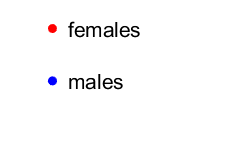Predictions & Data for this entry
| Model: abj | climate: MB, Cfa | migrate: | phylum: |
| COMPLETE = 2.5 | ecozone: MASW | food: bjPz, jiCi | class: |
| MRE = 0.032 | habitat: 0jMp, jiMcd, 0iFe, 0iMm | gender: D | order: |
| SMSE = 0.004 | embryo: Mp | reprod: O | family: |
Zero-variate data
| Data | Observed | Predicted | (RE) | Unit | Description | Reference |
|---|---|---|---|---|---|---|
| am | 7300 | 7338 | (0.005252) | d | life span | AtsuMasu2004 |
| Lp | 40 | 38.53 | (0.03676) | cm | total length at puberty for females | fishbase |
| Li | 103 | 101.1 | (0.01889) | cm | ultimate total length for females | fishbase |
| Wwb | 0.00022 | 0.00022 | (8.12e-05) | g | wet weight at birth | ADW |
| Wwp | 658 | 667.9 | (0.01509) | g | wet weight at puberty | fishbase |
| Wwi | 1.2e+04 | 1.205e+04 | (0.004202) | g | ultimate wet weight | fishbase |
| Ri | 5.205e+04 | 5.199e+04 | (0.001238) | #/d | maximum reprod rate | fishbase |
Uni- and bivariate data
| Data | Figure | Independent variable | Dependent variable | (RE) | Reference |
|---|---|---|---|---|---|
| tL_f |   | age | total length | (0.1022) | AtsuMasu2004 |
| tL_m |   | age | total length | (0.09199) | AtsuMasu2004 |
Pseudo-data at Tref = 20°C
| Data | Generalised animal | Paralichthys olivaceus | Unit | Description |
|---|---|---|---|---|
| v | 0.02 | 0.00503 | cm/d | energy conductance |
| p_M | 18 | 1232 | J/d.cm^3 | vol-spec som maint |
| k_J | 0.002 | 0.001931 | 1/d | maturity maint rate coefficient |
| k | 0.3 | 0.008255 | - | maintenance ratio |
| kap | 0.8 | 0.5294 | - | allocation fraction to soma |
| kap_G | 0.8 | 0.7942 | - | growth efficiency |
| kap_R | 0.95 | 0.95 | - | reproduction efficiency |
Discussion
- Males are assumed to differ from females by {p_Am} only
- I had to add 1 yr for tL data to arrive at a natural fit
Facts
- length - weight: Ww in g = 0.00794*(TL in cm)^3.07 (Ref: fishbase)
Bibliography